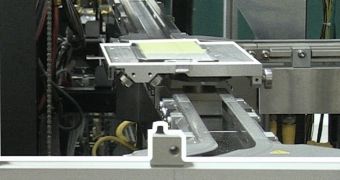Fused deposition modeling, stereolithography, selective laser sintering and many other 3D printing technologies have cropped up during the last three years. However, none of them have really solved the main problem, which is the speed of production.
Well, technically all those 3D printing technologies have been around for thirty years or so, but it’s only in the recent past that anything became of them. This only adds another reason why experts should hurry up and make the technology, well, hurry up.
You see, it still takes ages (read: days) for a single 3D model to be printed, and sometimes it takes several tries to pull it off properly.
So, in order for 3D printing to really take off, for it to replace the assembly lines of product cases, and products themselves, there is need for speed.
I don’t gamble. At all, mostly because I just never feel the urge to bet anything. If I had been a betting man, however, I would have – until, say, last week – been willing to wager that it would take at least a decade or two for 3D printing tech to reach a good enough turnout.
Which is to say, it would have taken a fair bit of time for the technologies mentioned above (and the others) to match paper printing in speed. Now, I’m not so sure.
There will be a great leap in speed by 2015
I’ve talked about this twice. Once last week, and once today, because 3D Systems was kind enough to elaborate on the technology it will use to produce the different components of the Google Project Ara modular smartphone.
The core of the matter is that the 3D printing technology it will use for manufacturing will have a speed fifty times greater than anything existing printers can achieve.
Sure, it has more to do with the layout of the printer itself than the extruder or filament: its design along the same principles as an assembly line, rather than a box-like contraption of table print bed.
However, the fact remains that, by 2015, it will be possible to print 4 billion drops a minute (with micron accuracy) and produce two liters of plastic resin every three minutes.
And the items will be made from more than one color too, as materials will be possible to combine easily on the racetrack-like manufacturing technology. What all this implies
The short of it is that 3D printing technology has shown itself to be uncanny in its progress. Essentially, it isn’t the sort of technological field that will advance gradually, like, say, CPUs.
No, so far 3D printing has advanced in leaps, and there is no reason to assume that this won’t continue to hold true. In three years it has gone from total unknown to the next holy grail of the worldwide industry. A foundation for the next industrial revolution even.
Sure, some say the hype is overblown, even the original creator of 3D printing technology, but when you’re already taking 3D printers into space in anticipation of establishing an orbital construction / manufacturing facility, you’re entitled to dream a bit.
All in all, the gist of what I’m saying is that consumer 3D printing shouldn’t take too long to improve print speed to the point where it matches the rate of laser/inkjet paper printing. 3D Systems has already shown one path. Someone just has to pave the way for consumer printers first, since the approach will have to be totally different. After all you can’t exactly build an assembly line in your bedroom or even garage (although I’m willing to admit that stranger things have happened).

 14 DAY TRIAL //
14 DAY TRIAL //